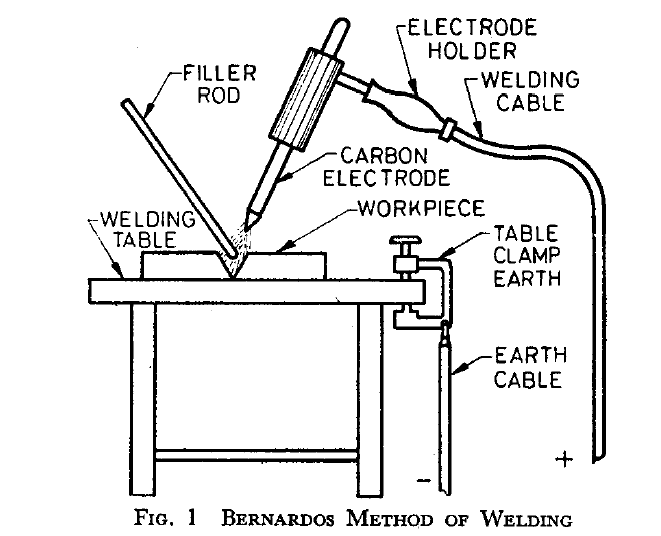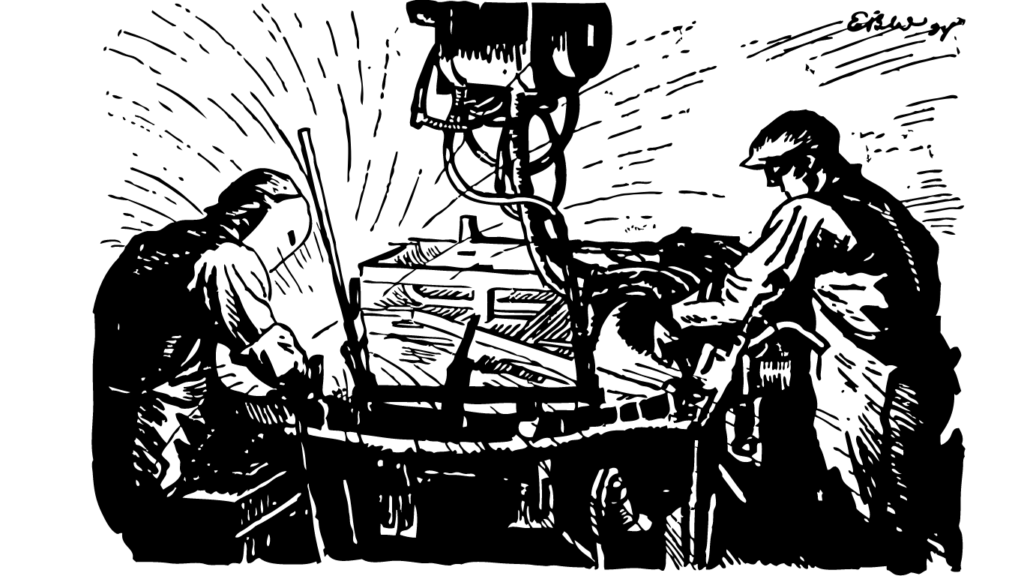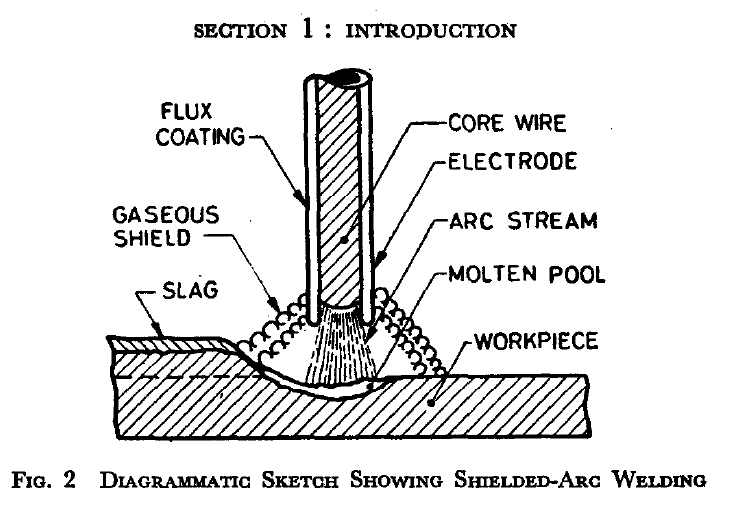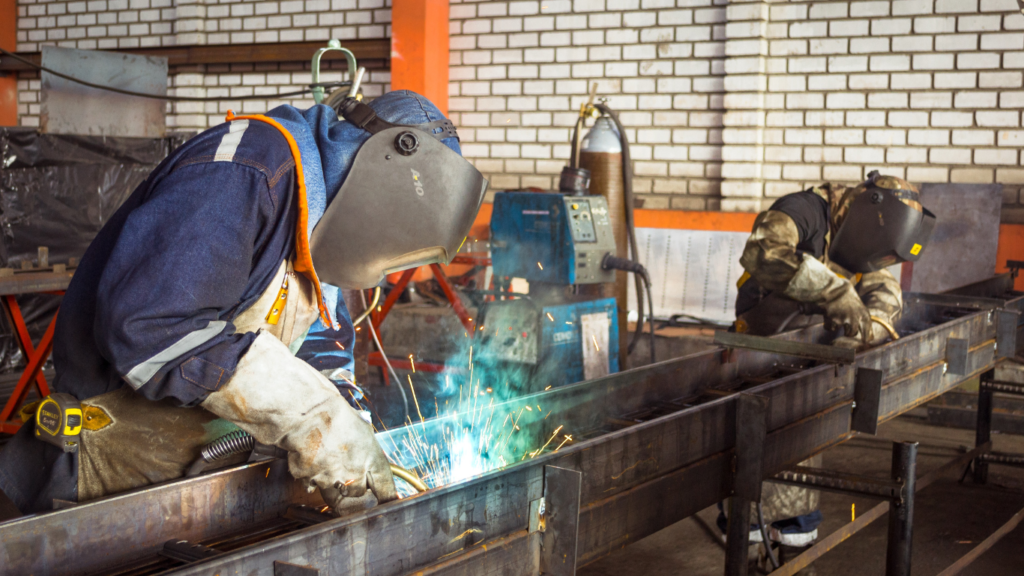
Table of Contents
Introduction
Welding is one of the most fundamental processes in the manufacturing, construction, and repair industries. It plays a pivotal role in various sectors, ranging from automotive and aerospace to structural engineering and fabrication of heavy equipment. Permanently joining two pieces of metal (and sometimes plastics or other materials) provides a robust and versatile method to create strong, reliable structures. The precision and strength offered by modern welding techniques have made it indispensable in creating everything from bridges and skyscrapers to pipelines and vehicles.
Historical Background of Welding
In its most basic form, welding can be traced back thousands of years. Early examples of rudimentary metalworking appeared as early as the Bronze Age (around 3000 BC), where metals were hammered and forged to join them together. The Egyptians also used heat-based metal joining techniques to craft their intricate gold jewelry.
However, welding, as it is recognized today, began its significant evolution during the 19th century. By the early 1800s, Sir Humphry Davy invented the electric arc, which was the foundation of arc welding. In 1881, French scientist Auguste de Méritens used this process to join lead plates in storage batteries. Russian engineer Nikolai Benardos and his colleague Stanisław Olszewski refined this process, introducing carbon arc welding.

In the early 20th century, the development of gas welding, oxy-fuel welding, and later the invention of more modern techniques such as TIG (Tungsten Inert Gas) and MIG (Metal Inert Gas) welding revolutionized the industry. By World War I and II, welding had become crucial for shipbuilding, tank production, and other military applications, accelerating innovation in the field.

Today, welding continues to evolve, with automation, robotics, and advanced materials playing significant roles in shaping its future.
What is Welding?
As per ISO welding is defined as “An operation by which two or more parts are united using heat or pressure or both, in such a way that there is continuity of the nature of the materials between the parts. A filler material, the melting point of which is of the same order as that of the parent materials, may or may not be used”.
Welding is the process of permanently joining two or more pieces of material, typically metals or thermoplastics, by applying heat, pressure, or both. The materials being joined, referred to as workpieces, are typically melted at the joint, and a filler material is often used to create a stronger bond between the two parts. Once the molten material cools, it solidifies, resulting in a durable and seamless connection.

While metals are the most welded materials, welding can also be used on plastics and other materials. Depending on the method and application, the welded joint can be as strong, or even stronger, than the base materials.
Types of Welding
There are several different types of welding processes, each suited to specific materials, applications, and industries. The choice of welding technique depends on various factors, including the materials to be joined, the desired strength of the joint, the working environment, and cost considerations. Below is an overview of some of the most widely used types of welding.

1. Arc Welding
Arc welding is the most used welding process and involves the creation of an electric arc between an electrode and the workpiece. This arc generates intense heat, melting the metal at the joint to form a bond.
Shielded Metal Arc Welding (SMAW)
Also known as stick welding, this process uses a consumable electrode coated in flux. The electrode melts during the process, forming the weld, while the flux creates a protective gas shield to prevent contamination. It is highly versatile and widely used for repairs and construction.
Gas Metal Arc Welding (GMAW) or MIG Welding
In this process, a continuous solid wire electrode is fed through a welding gun and into the weld pool. A shielding gas, such as argon or carbon dioxide, is used to protect the weld from atmospheric contamination. It is efficient, fast, and ideal for both thin and thick materials, commonly used in automotive and manufacturing industries.
Gas Tungsten Arc Welding (GTAW) or TIG Welding
This method uses a non-consumable tungsten electrode to produce the weld. A filler rod can be used if necessary, and an inert shielding gas protects the weld area. TIG welding provides high precision and is often used for thin materials like stainless steel and aluminum, particularly in the aerospace and automotive industries.
2. Oxy-Fuel Welding
Also known as oxyacetylene welding, this is one of the oldest forms of welding. It uses a flame fuelled by oxygen and acetylene gas to melt the metal at the joint. This technique is often used for cutting metals, but it can also weld metals, particularly in repair and construction.
While not as common in industrial settings as other welding methods, oxy-fuel welding is still valuable for its simplicity, portability, and ability to work without electricity. It is primarily used in small repair shops and for welding thinner metals.

3. Resistance Welding
Resistance welding relies on the principle of heat generated by electrical resistance. When an electric current passes through two workpieces, heat is generated at the joint, causing the materials to fuse.
Spot Welding
A common form of resistance welding, spot welding is used to join thin sheets of metal by applying pressure and heat at specific points. It is widely used in the automotive industry for joining metal parts in car bodies.
Seam Welding
Like spot welding, but instead of discrete points, a continuous seam is created by rolling electrodes along the joint. It is used to create leak-proof joints in products like fuel tanks and pipes.
4. Plasma Arc Welding
Like TIG welding, plasma arc welding uses a plasma torch to create a highly concentrated arc. The arc is more focused, allowing for deeper penetration and higher precision. Plasma arc welding is often used in aerospace applications due to its ability to weld very thin materials.
5. Laser Beam Welding
Laser beam welding uses a high-powered laser to heat and melt the materials being joined. This method is highly precise and can produce clean, strong welds with minimal distortion. It is particularly useful in industries that require detailed and precise welds, such as the automotive, electronics, and medical device sectors.
6. Electron Beam Welding
Electron beam welding involves using a focused beam of high-velocity electrons to melt the material at the joint. This method is performed in a vacuum to avoid interaction between the electron beam and air molecules. It is extremely precise and is often used in aerospace, automotive, and nuclear industries for high-quality welds.
Technological Advancements in Welding
Welding technology has advanced significantly over the years, especially with the advent of automation, robotics, and computer-aided design (CAD) software. These innovations have increased efficiency, precision, and safety in welding operations.
Robotic Welding
Automated welding systems are now widely used in industries such as automotive manufacturing, where precision, speed, and repeatability are critical. Robotic welding systems can perform complex welds with high accuracy and consistency, reducing the need for human intervention in dangerous environments.

3D Welding and Additive Manufacturing
Additive manufacturing, or 3D printing, has introduced new ways to combine welding and manufacturing. In this process, layers of material are welded together to form 3D structures, providing new possibilities for customized and complex shapes in industries like aerospace and biomedical engineering.
Laser Hybrid Welding
Combining laser beam welding with arc welding, this method offers deeper penetration, increased welding speeds, and better control over the weld pool. It is becoming increasingly popular in industries where efficiency and strength are key.
Ultrasonic Welding
Used primarily for joining plastics and other non-metallic materials, ultrasonic welding uses high-frequency vibrations to create frictional heat at the joint, fusing the materials. It is commonly used in electronics, medical devices, and packaging industries.
Equipment Required for Welding
The specific equipment required for welding depends on the type of welding process being used. However, the following general tools are typically needed across various methods:
Welding Power Source: This provides the electrical energy needed to create the welding arc or resistance heat.
Electrode: Either consumable or non-consumable, electrodes carry the current and create the arc.
Welding Torch or Gun: Used to hold and manipulate the electrode or filler material.
Protective Gear: Welders need personal protective equipment (PPE), such as welding helmets, gloves, jackets, and safety glasses, to protect against heat, sparks, UV radiation, and fumes.

Shielding Gas: For processes like MIG, TIG, and plasma welding, a shielding gas such as argon or carbon dioxide is used to protect the weld from contamination.
Filler Material: In many welding processes, a filler metal is added to the joint to help bond the workpieces.
Applications of Welding
Welding has a wide range of applications across various industries, including:
Automotive Industry: Welding is essential in manufacturing cars, trucks, and buses, with techniques like spot welding and robotic arc welding being widely used.
Aerospace Industry: High-precision welding methods like TIG and plasma welding are employed to fabricate aircraft and spacecraft components.
Construction Industry: Welding is critical in building bridges, skyscrapers, pipelines, and offshore platforms, providing the strength and durability needed for these massive structures.
Manufacturing: Many products, from household appliances to heavy machinery, rely on welding for assembly and repair.

Shipbuilding: Welding is extensively used to construct ships, submarines, and other marine vessels.
Energy Industry: The oil and gas, nuclear, and renewable energy sectors use welding in constructing pipelines, pressure vessels, and wind turbines.
Conclusion
Welding has evolved from ancient blacksmithing techniques to highly sophisticated methods employing lasers, robotics, and automation. Its role in modern manufacturing, construction, and industrial applications is indispensable.

